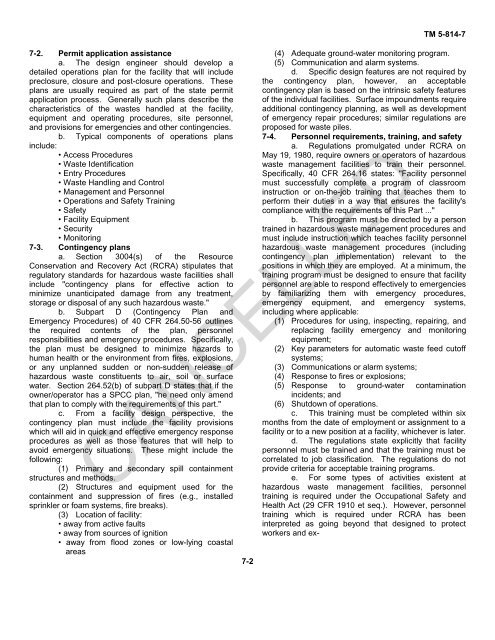UFC 3-280-02A Hazardous Waste Land Disposal/Land Treatment ...
UFC 3-280-02A Hazardous Waste Land Disposal/Land Treatment ...
UFC 3-280-02A Hazardous Waste Land Disposal/Land Treatment ...
You also want an ePaper? Increase the reach of your titles
YUMPU automatically turns print PDFs into web optimized ePapers that Google loves.
7-2. Permit application assistancea. The design engineer should develop adetailed operations plan for the facility that will includepreclosure, closure and post-closure operations. Theseplans are usually required as part of the state permitapplication process. Generally such plans describe thecharacteristics of the wastes handled at the facility,equipment and operating procedures, site personnel,and provisions for emergencies and other contingencies.b. Typical components of operations plansinclude:• Access Procedures• <strong>Waste</strong> Identification• Entry Procedures• <strong>Waste</strong> Handling and Control• Management and Personnel• Operations and Safety Training• Safety• Facility Equipment• Security• Monitoring7-3. Contingency plansa. Section 3004(s) of the ResourceConservation and Recovery Act (RCRA) stipulates thatregulatory standards for hazardous waste facilities shallinclude "contingency plans for effective action tominimize unanticipated damage from any treatment,storage or disposal of any such hazardous waste."b. Subpart D (Contingency Plan andEmergency Procedures) of 40 CFR 264.50-56 outlinesthe required contents of the plan, personnelresponsibilities and emergency procedures. Specifically,the plan must be designed to minimize hazards tohuman health or the environment from fires, explosions,or any unplanned sudden or non-sudden release ofhazardous waste constituents to air, soil or surfacewater. Section 264.52(b) of subpart D states that if theowner/operator has a SPCC plan, "he need only amendthat plan to comply with the requirements of this part."c. From a facility design perspective, thecontingency plan must include the facility provisionswhich will aid in quick and effective emergency responseprocedures as well as those features that will help toavoid emergency situations. These might include thefollowing:(1) Primary and secondary spill containmentstructures and methods.(2) Structures and equipment used for thecontainment and suppression of fires (e.g., installedsprinkler or foam systems, fire breaks).(3) Location of facility:• away from active faults• away from sources of ignition• away from flood zones or low-lying coastalareas7-2TM 5-814-7(4) Adequate ground-water monitoring program.(5) Communication and alarm systems.d. Specific design features are not required bythe contingency plan, however, an acceptablecontingency plan is based on the intrinsic safety featuresof the individual facilities. Surface impoundments requireadditional contingency planning, as well as developmentof emergency repair procedures; similar regulations areproposed for waste piles.7-4. Personnel requirements, training, and safetya. Regulations promulgated under RCRA onMay 19, 1980, require owners or operators of hazardouswaste management facilities to train their personnel.Specifically, 40 CFR 264.16 states: "Facility personnelmust successfully complete a program of classroominstruction or on-the-job training that teaches them toperform their duties in a way that ensures the facility'scompliance with the requirements of this Part ..."b. This program must be directed by a persontrained in hazardous waste management procedures andmust include instruction which teaches facility personnelhazardous waste management procedures (includingcontingency plan implementation) relevant to thepositions in which they are employed. At a minimum, thetraining program must be designed to ensure that facilitypersonnel are able to respond effectively to emergenciesby familiarizing them with emergency procedures,emergency equipment, and emergency systems,including where applicable:(1) Procedures for using, inspecting, repairing, andreplacing facility emergency and monitoringequipment;(2) Key parameters for automatic waste feed cutoffsystems;(3) Communications or alarm systems;(4) Response to fires or explosions;(5) Response to ground-water contaminationincidents; and(6) Shutdown of operations.c. This training must be completed within sixmonths from the date of employment or assignment to afacility or to a new position at a facility, whichever is later.d. The regulations state explicitly that facilitypersonnel must be trained and that the training must becorrelated to job classification. The regulations do notprovide criteria for acceptable training programs.e. For some types of activities existent athazardous waste management facilities, personneltraining is required under the Occupational Safety andHealth Act (29 CFR 1910 et seq.). However, personneltraining which is required under RCRA has beeninterpreted as going beyond that designed to protectworkers and ex-CANCELLED
















